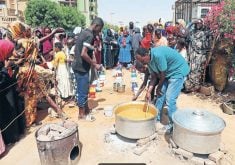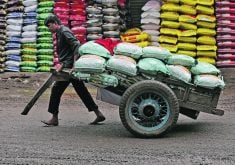Canada supplied 17 percent of the World Food Programme’s pulses last year and the agency wants more
CALGARY — A big buyer of Canadian pulses wants to become an even bigger buyer.
The World Food Programme bought 46,385 tonnes of Canadian lentils, peas, chickpeas and beans last year.
“One of my main reasons to be here is to see how we can increase that number,” Mahadevan Ramachandran, head of strategy, performance and risk in procurement for the United Nations agency, told delegates attending the Pulse & Special Crops Convention.
Pulses comprise 15 percent of the organization’s $1.25 billion in annual food purchases.
They are one of four main items in its basic food basket, along with cereals, oil and salt.
Read Also

Gene editing digs deeper space in Canadian plant breeding
More Canadian research into crop variety development is incorporating gene editing, and one researcher notes that Canada’s regulatory approach to gene editing will help drive innovation
Canadian pulses accounted for 17 percent of the 276,006 tonnes of pulses that the food program bought in 2014.
Ramachandran wants to see that percentage rise because Canada supplies some of the best quality pulses in the world.
Quality is an important attribute because the pulses are shipped to some of the most difficult regions in the world.
“I’ve been in northern Niger where the pulse bag sits in the warehouse at 40 degree heat for three months, so obviously having very good quality grain helps us,” he said.
Canada has also proven to be one of the most reliable suppliers over the past five years, which is important because the program deals with crisis situations where food is needed at the right place at the right time.
Russia is the top supplier of pulses to the program followed by Canada, Ethiopia, Ukraine and Malawi.
Ramachandran worries sanctions against Russia will reduce Russian pulse production and exports.
He expects Russia to be less of a player in 2015 and 2016, which is another reason he’d like to see more Canadian exporters registering with the program and bidding on tenders.
The food program helps 80 to 100 million people a year in 80 countries. The top three regions of demand are East Africa, the Middle East and West Africa.
That poses a problem for Canadian suppliers because it is hard to be cost effective when shipping to those far-away destinations, and price is a big factor when awarding tenders.
Ramachandran thinks Canadians can be more competitive when it comes to providing bio-fortified pulses for the program’s special nutritious food program, which consumes another 60,000 to 80,000 tonnes of pulses annually.
The program provides nutrition for 15 to 20 million children annually.
“We could be looking at a slightly nuanced higher value product from Canada,” he said.
Ramachandran would also like to work with Canadian exporters to provide food to individual government food programs.
He said 91 of the 134 countries the organization researched in Africa and Asia have large food programs.
Those governments spend $100 to $150 billion annually on those food programs, and he believes Canadian pulses would be a good fit.
“The Indian government alone moves about five to 10 million tonnes of pulses through its system,” he said.
sean.pratt@producer.com















